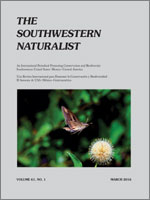I compared riparian cottonwood (Populus fremontii) productivity-discharge relationships in a relictual stand along the highly regulated Green River and in a naturally functioning stand along the unregulated Yampa River in semiarid northwest Colorado. I used multiple regression to model flow effects on annual basal area increment (BAI) from 1982 to 2011, after removing any autocorrelation present. Each BAI series was developed from 20 trees whose mean size (67 cm diameter at breast height [DBH]) was equivalent in the two stands. BAI was larger in the Yampa River stand except in 2 y when defoliating leaf beetles were present there. I found no evidence for a Yampa flood-magnitude threshold above which BAI declined. Flow variables explained ∼45% of residual BAI variability, with most explained by current-year maximum 90-d discharge (QM90) in the Yampa River stand and by a measure of the year-to-year change in QM90 in the Green River stand. The latter reflects a management-imposed ceiling on flood magnitude—Flaming Gorge Dam power plant capacity—infrequently exceeded during the study period. BAI in the relictual stand began to trend upward in 1992 when flows started to mimic a natural flow regime. Mature Fremont cottonwoods appear to be ecologically resilient. Their productivity along regulated rivers might be optimized using multiyear environmental flow designs.
How to translate text using browser tools
1 March 2016
Flow regime effects on mature Populus fremontii (Fremont cottonwood) productivity on two contrasting dryland river floodplains
Douglas C. Andersen
ACCESS THE FULL ARTICLE

The Southwestern Naturalist
Vol. 61 • No. 1
March 2016
Vol. 61 • No. 1
March 2016




